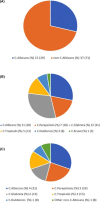Epidemiology and Mycology of Candidaemia in non-oncological medical intensive care unit patients in a tertiary center in the United States: Overall analysis and comparison between non-COVID-19 and COVID-19 cases
- PMID: 33608923
- PMCID: PMC8013328
- DOI: 10.1111/myc.13258
Epidemiology and Mycology of Candidaemia in non-oncological medical intensive care unit patients in a tertiary center in the United States: Overall analysis and comparison between non-COVID-19 and COVID-19 cases
Abstract
The epidemiology and mycology of invasive candidiasis in the ICU is well-described in certain types of critically ill patients but not in others. One population that has been scarcely studied is non-neutropenic patients admitted specifically to medical ICUs. Even less is known about the broader category of medical ICU patients without active oncological disease. This group constitutes a very large share of the patients requiring critical care across the globe, especially in the era of the SARS-CoV-2 pandemic. We analysed medical ICU candidaemia episodes that occurred in non-oncological patients in our tertiary academic centre in the United States from May 2014 to October 2020 to determine the incidence and species distribution of the associated isolates. We then separately considered non-COVID-19 and COVID-19 cases and compared their characteristics. In the non-COVID-19 group, there were 38 cases for an incidence of 1.1% and rate of 11/1000 admissions. In the COVID-19 group, there were 12 cases for an incidence of 5.1% and rate of 51/1000 admissions. In the entire sample, as well as separately in the non-COVID-19 and COVID-19 groups,Candida albicans accounted for a minority of isolates. Compared to non-COVID-19 patients with candidaemia, COVID-19 patients had lower ICU admission SOFA score but longer ICU length of stay and central venous catheter dwell time at candidaemia detection. This study provides valuable insight into the incidence and species distribution of candidaemia cases occurring in non-oncological critically ill patients and identifies informative differences between non-COVID-19 and COVID-19 patients.
Keywords: COVID-19; Candidaemia; coronavirus; invasive candidiasis; medical intensive care unit; mycology.
© 2021 The Authors. Mycoses published by Wiley-VCH GmbH.
Conflict of interest statement
The authors have no conflicts of interest to disclose.
Figures
References
-
- Chakrabarti A, Sood P, Rudramurthy SM, et al. Incidence, characteristics and outcome of ICU‐acquired candidemia in India. Intensive Care Med. 2015;41:285‐295. - PubMed
-
- Motoa G, Muñoz JS, Oñate J, Pallares CJ, Hernández C, Villegas MV. Epidemiology of Candida isolates from Intensive Care Units in Colombia from 2010 to 2013. Rev Iberoam Micol. 2017;34:17‐22. - PubMed
-
- da Silva RB, Neves RP, Hinrichsen SL, de Lima‐Neto RG. Candidemia in a public hospital in Northeastern Brazil: epidemiological features and risk factors in critically ill patients. Rev Iberoam Micol. 2019;36:181‐185. - PubMed
-
- Bougnoux ME, Kac G, Aegerter P, d'Enfert C, Fagon JY, CandiRea Study Group . Candidemia and candiduria in critically ill patients admitted to intensive care units in France: incidence, molecular diversity, management and outcome. Intensive Care Med. 2008;34:292‐299. - PubMed
MeSH terms
LinkOut - more resources
Full Text Sources
Other Literature Sources
Medical
Miscellaneous


